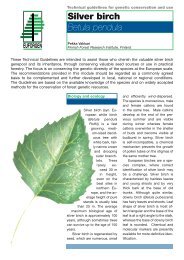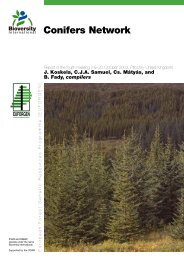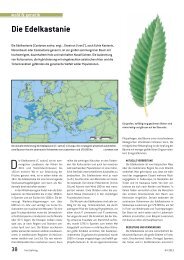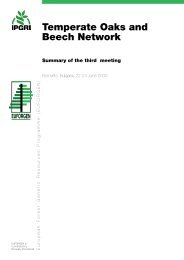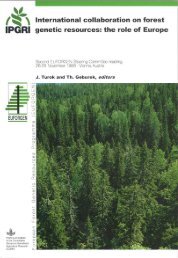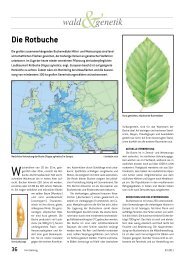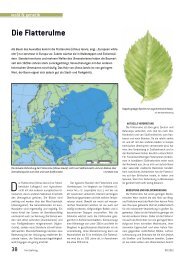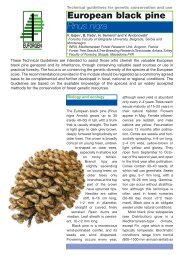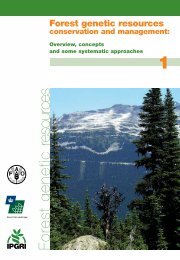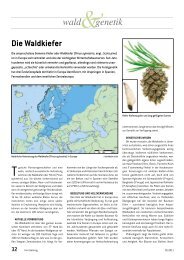Download PDF - Euforgen
Download PDF - Euforgen
Download PDF - Euforgen
You also want an ePaper? Increase the reach of your titles
YUMPU automatically turns print PDFs into web optimized ePapers that Google loves.
" COUNTRY REPORTS 31<br />
Conservation aims and current state of conservation activities<br />
On the territory of Slovakia the first regulation aimed at seed procurement from approved<br />
stands was adopted in 1938. In keeping with this legal regulation, the seeds of conifers<br />
(Norway spruce, silver fir, Scots pine and European larch) could be collected only in<br />
approved stands (A and B category) and seed transfer was allowed only within 'silvicultural'<br />
seed zones. The silvicultural zones were defined according to their geographical distribution<br />
and the length of vegetation period.<br />
Subsequently these regulations were updated in 1965 and again in 1985 and 1988. The<br />
last one also includes seed procurement from the approved seed stands and the seed transfer<br />
within seed zones for pedunculate and sessile oak and beech.<br />
Oaks and beech were absent from the first regulations because these tree species were<br />
mainly regenerated naturally. In oaks the artificial regeneration by seeding and planting<br />
was more common than in beech. At present the proportion of beech reforestation in<br />
Slovakia is rather high. Beech is frequently a component of combined regenerations to<br />
establish mixed forest stands.<br />
For beech there are four seed zones within the natural range (Sub-Tatra, Eastern Slovakia,<br />
Central Slovakia and Little Carpathians) and two zones outside the natural range (Tatra and<br />
Southern Slovakia), for sessile oak there are three zones within the natural range (Eastern<br />
Slovakia, Central Slovakia and Southern Slovakia) and three seed zones outside the natural<br />
range (Northern Slovakia, Western Slovakia and Southeastern Slovakia). For pedunculate<br />
oak there are three zones within its natural range (Western Slovakia, Southeasern Slovakia<br />
and Southern Slovakia) and three zones outside the natural range (Northern Slovakia,<br />
Eastern Slovakia and Central Slovakia). Vertical transfer of seeds is allowed within ±200 m<br />
for beech and ±150 m for oaks from the altitude of approved stands where the seed was<br />
collected.<br />
At present, 111 gene reserves are defined for all tree species in Slovakia, five (1200 ha)<br />
and six of them (1119 ha) are established only for beech and oaks, respectively, seven of<br />
them (3637 ha) for mixed stands composed of oaks and beech, and seven gene reserves<br />
(3663 ha) for mixed stands composed of tree species other than beech and oaks. They occur<br />
mainly in central Slovakia and some in western and eastern Slovakia.<br />
Facilities for long-term conservation of acorns and beech nuts have been built up in<br />
Liptovsky Hradok. In these facilities the storage of acorns and beech nuts can be maintained<br />
up to 5 years to cover the time gaps between the seed years.<br />
Four provenance trials have been established with beech. Those established in 1968-1972<br />
and 1982 comprise the Slovak and Czech provenances (20 and 27, respectively) (Cervenka<br />
and Paule 1982; Paule 1982). The latter two are a part of international provenance<br />
experiments coordinated by the Federal Forestry Research Center in Grosshansdorf,<br />
Germany, containing 100 and 31 provenances, respectively. Trials were established in 1996<br />
and 1998.<br />
At present there are 74 forest reserves, of which 5% are in the oak forest vegetation zone,<br />
2.42 and 3.78% are in the beech-oak and oak-beech forest vegetation zones, respectively, and<br />
9.19% in the beech forest vegetation zone. For comparison, the proportion of nature reserves<br />
in the first four forest vegetation zones (20.39%) is about one-third of the total proportion<br />
(69.41%) in the forests in Slovakia. It means that there is a lower proportion of virgin and<br />
natural forests with oaks and beech than would be expected according to the general<br />
occurrence (V oloscuk 1993).<br />
Nevertheless, there are also some natural oak forests with Q. robur (Palarikovo) or<br />
Q. petraea (Kasivarova, Bujanov, Sitno) as well as numerous beech virgin forests in eastern<br />
Slovakia (e.g. Vihorlat, Stuzica, Rozok,) whose size ranges from 16 ha (Kasivarova) to 600 ha<br />
(Stuzica) (Korpel' 1993). The forest reserves are in most cases a part of gene reserves,<br />
although the legal status of both categories is defined by two different Acts (Nature<br />
Protection Act and Forestry Act and accompanying regulations). The most common<br />
occurrence of beech forests in Slovakia (and also the forest reserves) is in eastern Slovakia



